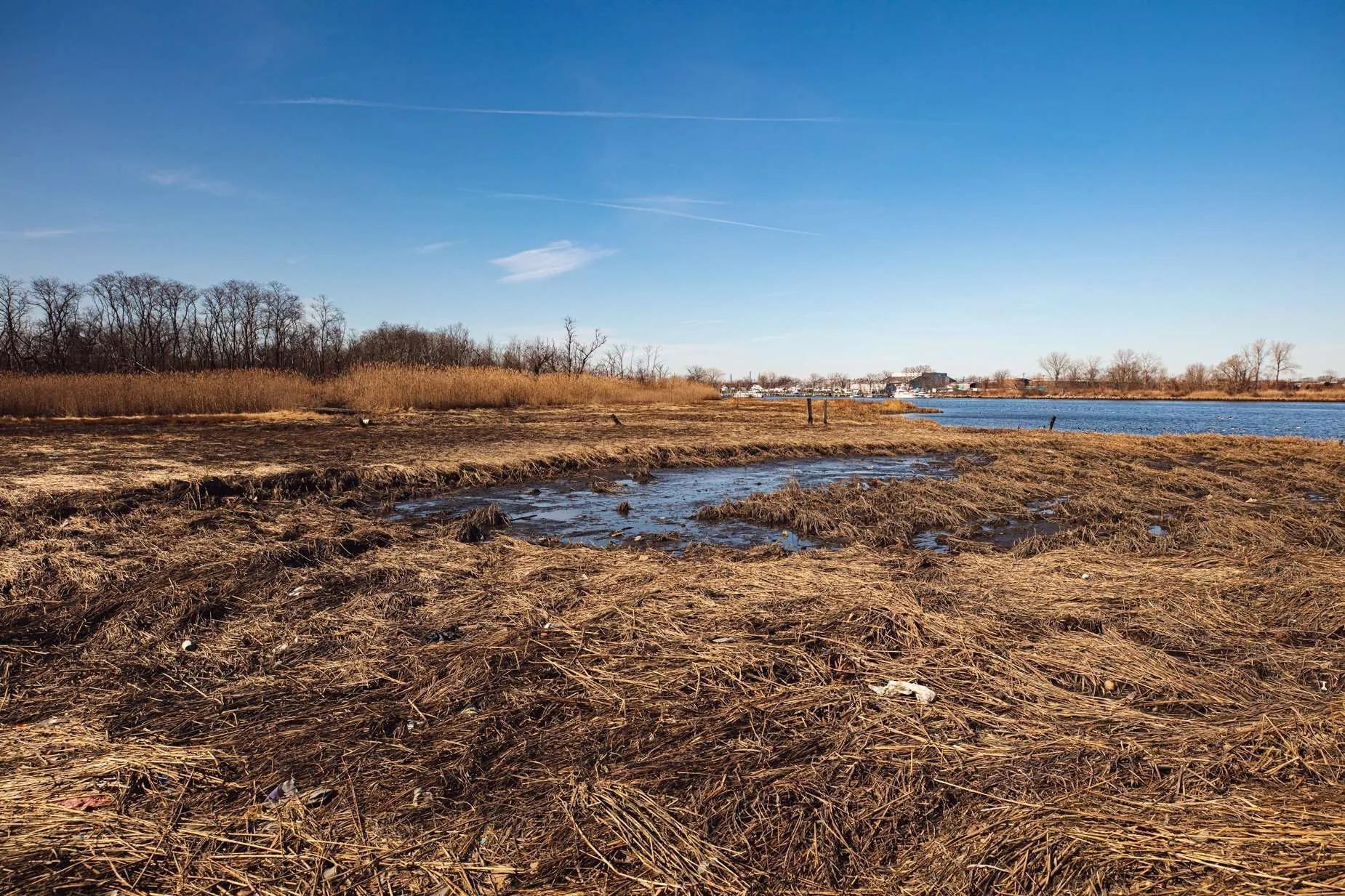A Conversation with Artist Jeremy Dennis
A Collections Chronicles Blog
By Martina Caruso, Director of Collections and Exhibitions
November 1, 2025
Imagine a lonely warrior slumped over his horse, backlit by a sun setting over rolling hills, or a group of warriors riding off toward the horizon. It isn’t hard for most people to conjure because we have been raised on these romantic images of the so-called vanishing Indian. Photography, which developed hand in hand with colonialism, has largely been responsible for the continued stereotype of the noble savage. What “Indians” are admired for—the idea of being one with nature, one with the land and animals—is also seen as the source of their inferiority and inevitable demise. – curator Wanda Nanibush explained in Notion of Land, published in Aperture magazine in Spring of 2019.[1]From “Wanda Nanibush Notions Of Land. For Indigenous artists, how can photographs provide a space of visual sovereignty?” Aperture magazine, Spring 2019
From the beginning of photography, Indigenous people were largely photographed by white men. In the mid-late 19th century, the photographic documentation of Native individuals and communities across North America occurred simultaneously with the massive government projects to support the colonization of territories for European and Euro-American settlers. These initiatives aimed to assimilate and/or erase Native people from the continent, as photography itself was considered part of the proof of white superiority, because of the medium’s basis in technological innovation.
The new medium of photography was used to link Indigenous people to the idea of nature in order to compare them to white-settlers communities and their supposed introduction of civilization. To varying degrees, these photographs present stereotypical images of the Native people they immortalize, including elaborate backgrounds, dress-making, props, and lighting.
I recently talked with Jeremy Dennis (b. 1990), a fine art photographer and Tribal Member of the Shinnecock Indian Nation in Southampton, New York. Below is a transcript of our recent conversation about his work and practice, his visits to the South Street Seaport, and the work the Museum is doing to diversify and develop its collections.
The two of us first met in September 2023, when he was one of three artists selected for Art at the Edge, a free outdoor exhibition produced by The Waterfront Alliance, in collaboration with the Seaport Museum, Photoville, and The Howard Hughes Corporation. At the end of that year, the Seaport Museum acquired two of his photographs as part of our ongoing efforts to continue developing our collections, following the mission and vision of the South Street Seaport Museum of today.
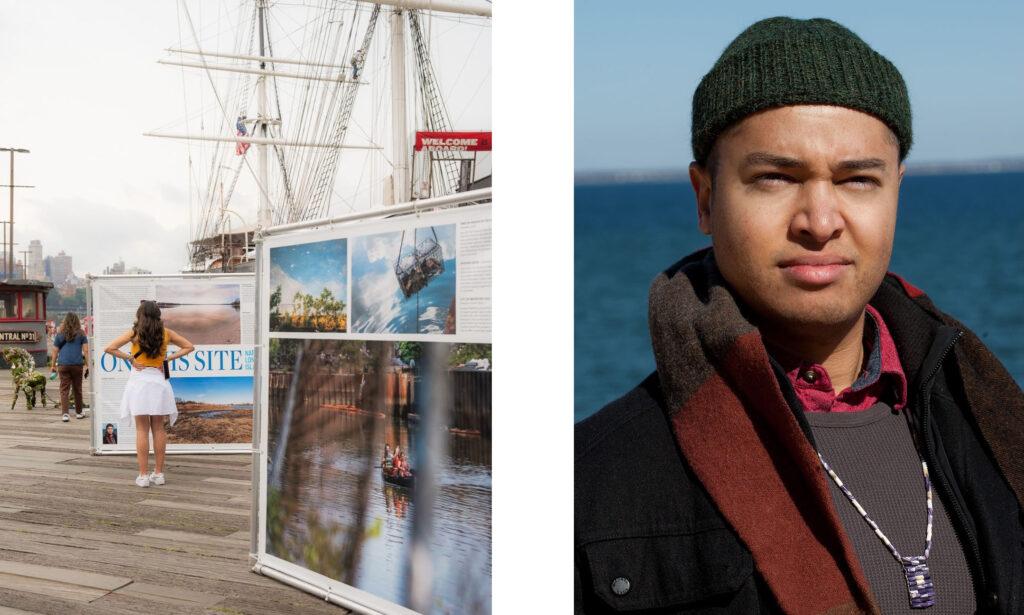
Martina Caruso: Maybe we should start off by talking a bit about your upbringing—and what influences you, beyond your academic background.
Jeremy Dennis: Oh, absolutely, I’d love to talk a little bit about that. First, I grew up on the Shinnecock Indian Nation territory in Southampton, New York, and I was surrounded by family, community, and stories about our land, and of course, where we come from. Just the simple, amazing fact that we have been here for over 10,000 years stimulates a lot of inspiration. I think talking to elders and the youth, everyone has a different priority on which direction we want to see the Nation going. So, I would say that, home and Shinnecock Nation, that’s where a lot of my art spawns from.
When it comes to academic training, I went to SUNY Stony Brook, and then, for my MFA, I went to Penn State. But a lot of the photography is somewhat self-taught. I think I learned a little bit of 35-millimeter dark room digital printing and editing, and a lot of what I do now is just digital photography.
Caruso: Native people—artists, community members, elders, matriarchs, and other knowledge-keepers—have always been leaders in matters of environmental and social justice, understanding and championing the inalienable rights of land, water, air, and all living beings. How do you feel about being a part of this important and essential practice and history?
Dennis: Being part of this tradition feels like a responsibility, which is heavy and also an honor that helps move the work forward. When I was growing up, I didn’t really see a lot of our community represented in art, and when it was represented, it was usually in negative terms. So, I felt like it was an awesome opportunity to basically look back and see what our community was up to.
Since we have such diversity within the nation, not only are our native tribal communities so unique and individual, but our tribal community is as well. I think it’s really interesting to sometimes just celebrate who we are in simple terms, whether it’s just individual portraits or interviews. I love that style, especially within tribal communities, because so much of what is told about us is hearsay or “someone told someone a story.” A lot of it is also fear-based. So, one thing that I see as a political act is being able to tell our own story.
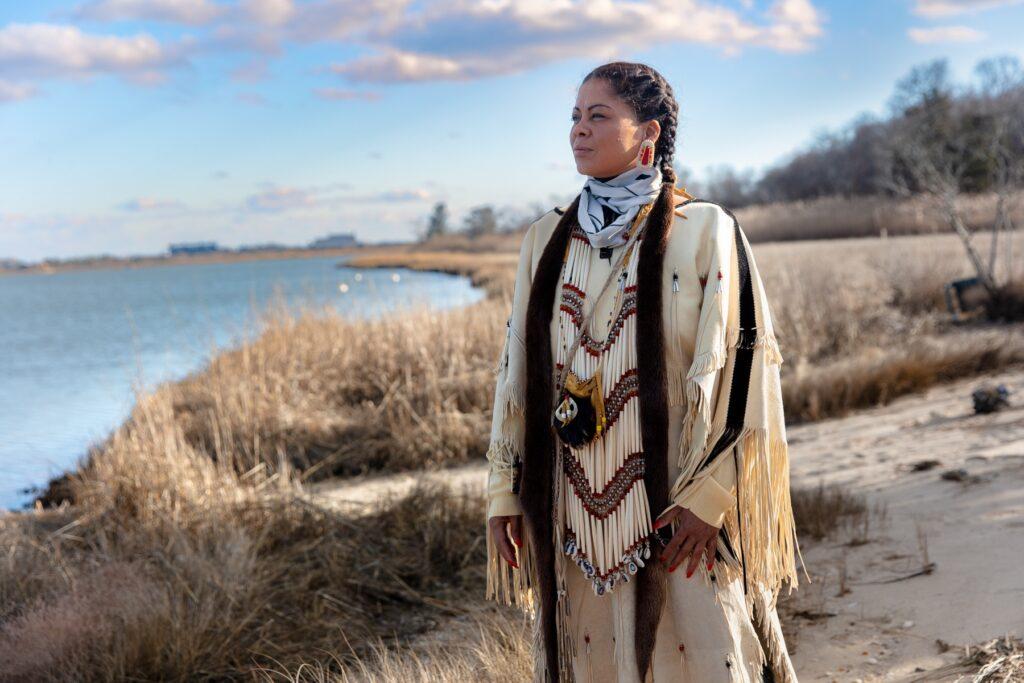
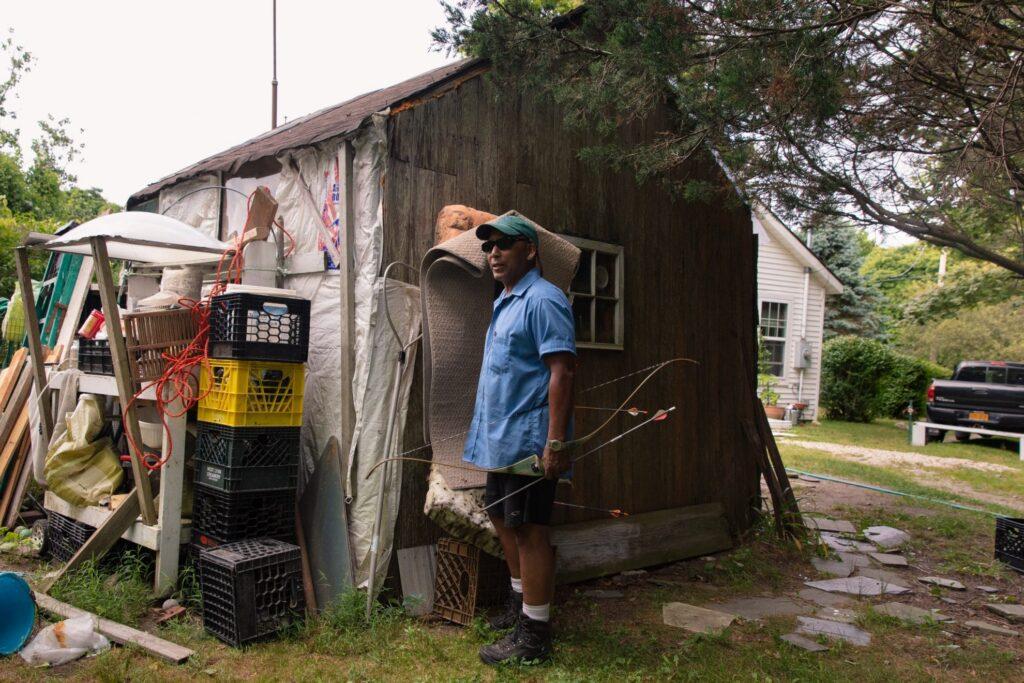
Left: Nicole Dennis Banks, 2019.
Right: Keith, 2018.
I think I’m constantly inspired by our elders, the work that was done before us. I’m also thinking a lot about opportunities that I have today as an artist, and how even in my mom’s generation, it was so deterred. And so, when I photograph the land, or the scenes I sometimes stage within my work—whether it’s creation stories or political scenes—I don’t think it’s just documenting the scene as is. I’m showing a side within our community that maybe people don’t necessarily get to see and get to appreciate.
Caruso: I keep thinking of the term “visual sovereignty”—the right of Indigenous people to determine how they are represented. I feel that your work is the quintessential representation of the Shinnecock Nation. Can you expand on your practice in this environment?
Dennis: When I look at my own work—and especially where I grew up, the Hamptons—I do, unfortunately, have to contend with this idea that you really can’t trust the viewer to look beyond the image. They’re maybe biased or they’re perhaps misunderstanding traditions based on what they learned at school and in their upbringing. A lot of times, people don’t have a sense of how things could be different from the way they are. And so, all of my work usually comes with a wall text that is instructional. I usually do “require” people to read something before they understand what they’re looking at.
I do have a project called On This Site, which started in 2016 and is all about trying to share place-based history. It is a little bit boring, even in my own opinion, just to see these sites when you have no context, when you enter a room and, as a viewer, you just see these images. But when I take these photos, it’s amazing, it feels like a historic moment or an accomplishment just being able to stand in the footsteps of my ancestors. I really love that possibility—the idea of reflecting on how far we’ve come as Indigenous people and the resilience that we’ve shown.
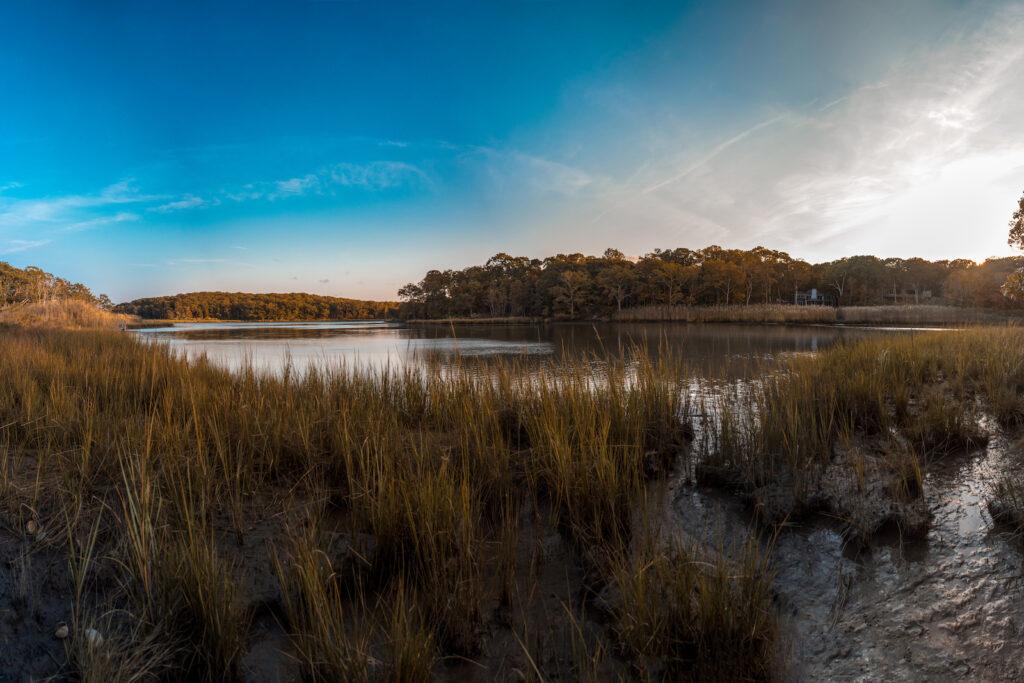
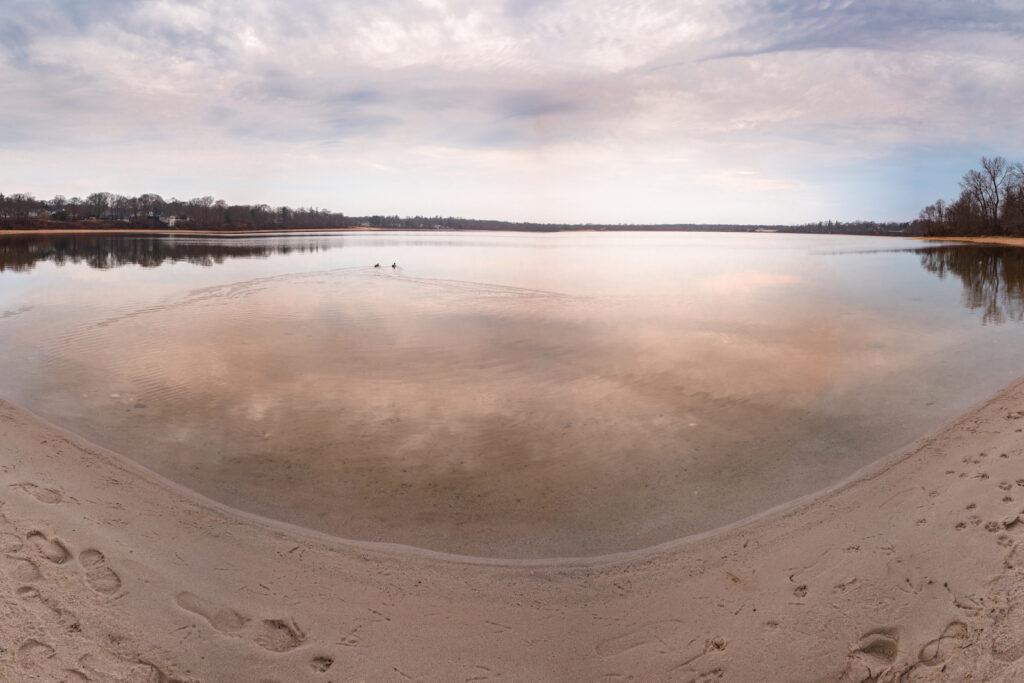

Left: “Ashawagh“, a pre-contact Montaukett settlement on the edge of Copeces, now Hand’s Creek. Shell heaps in the area suggest intense wampum manufacturing. This place was particularly important for hunting, fishing, and camping.
Center: “Ronkonkoma“, once a freshwater pond with a prehistoric village settlement. Many romanticized and false nineteenth and twentieth-century legends are associated with this site. Today, the water of Lake Ronkonkoma has been deemed too toxic for swimming.
Right: “Indian Island“, a site of spiritual significance. During a 2005 storm, the beach eroded exposing burials and artifacts. The Shinnecock and Unkechaug, in cooperation with the Riverhead Park and Town supervisors, repatriated the remains.
Caruso: Where do your projects begin and how does your art practice enable you to explore and expand your ideas?
Dennis: I think it’s interesting that a lot of the work that I do as an artist is on the East End of Long Island, and a lot of the support I get comes from Upstate New York or outside the region. I do love going to artist residencies. Right now I am in Italy, and I would say 90% of the work I get done, and is in my portfolio, is thanks to these spaces. At the end of October I will be in Santa Fe for a month, creating art there thanks to another residency. Because where I live in the Hamptons, studio spaces, real estate, and rentals are impossible to even think about affording, especially as an artist. So when I go to these residencies, I’m offered a new environment, a whole different network of creatives, and, simply put, just space to think and create.
Caruso: How do you typically showcase your work? What are your aspirations or ideals in terms of presenting your art?
Dennis: When it comes to showing work, I love the outdoors. I love public spaces. One of my favorite projects was the one we worked on together a couple of years ago. For the Art at the Edge, I wanted to save the banners and reuse them, because it was such a smart idea; I never did anything like that before.
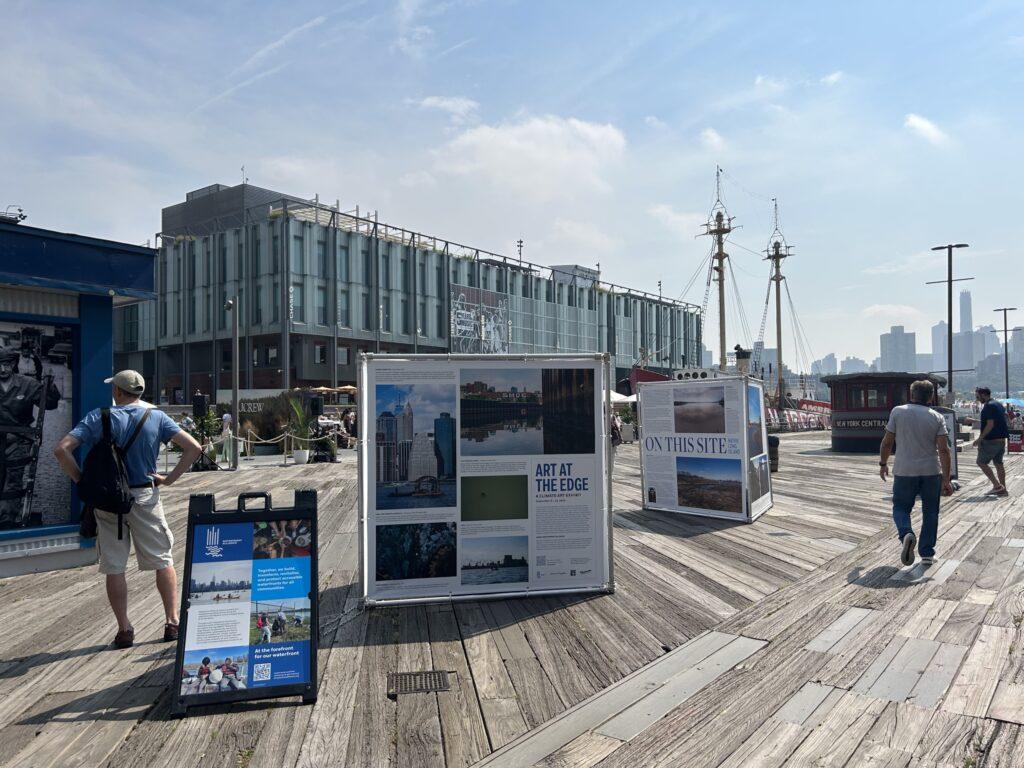
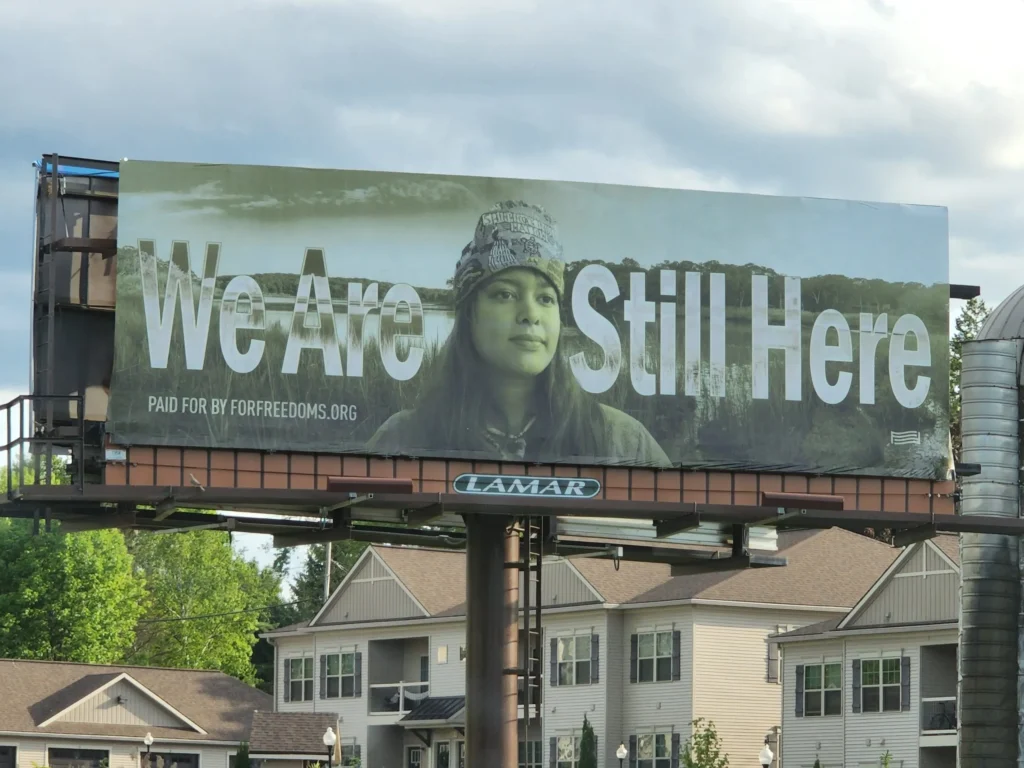
Left: Art At The Edge, Septemeber 2023.
Right: We Are Still Here, 2022. Photo by waniwanipanicdj and Victor Miranda.
I think that being outside is a key aspect of being a contemporary artist. Sometimes you have to bring the art to the people. These days, a lot of people are just scraping by, or just going to work, or are just too tired to go to museums. So I love how the public can contend with what artists are thinking about. But I do love museums and academic spaces as well, and so far I have worked with places that have been really open to the work that I’m doing. Lastly, commercially, I’ve had a lot more difficulties being able to find support, or collectors, or patrons, to keep my work going. But I do want my work to live in multiple worlds, out on the street where anyone can get a view of it, as well as inside institutions that may be academic, where they can do research, bring more meaning to it, and future generations of visitors can look at that too.
Caruso: Recently, you were part of the show Speaking with Light: Contemporary Indigenous Photography at the Amon Carter Museum of American Art, which was one of the first major museum surveys to explore the investigation into identity, resistance, and belonging, featuring works by more than 30 Indigenous artists. How important was this exhibition for your work?
Dennis: It was an awesome concept, and working with Amon Carter was so incredible. The show was in 2023 and, for the whole year before, we were discussing works for their collection. It’s so rare as an artist to work with an institution that takes so much care going into the show and into your art.
The title “Speaking with Light” is essentially what photography is. They ended up choosing works for my portfolio from a series called “Nothing Happened Here,” a photography series that explores the violence/non-violence of post-colonial Native American psychology. The prints depict non-native people who are impaled by arrows, and it’s meant to talk about why we sometimes have shared damaged enthusiasm of living on Indigenous lands without rectification.

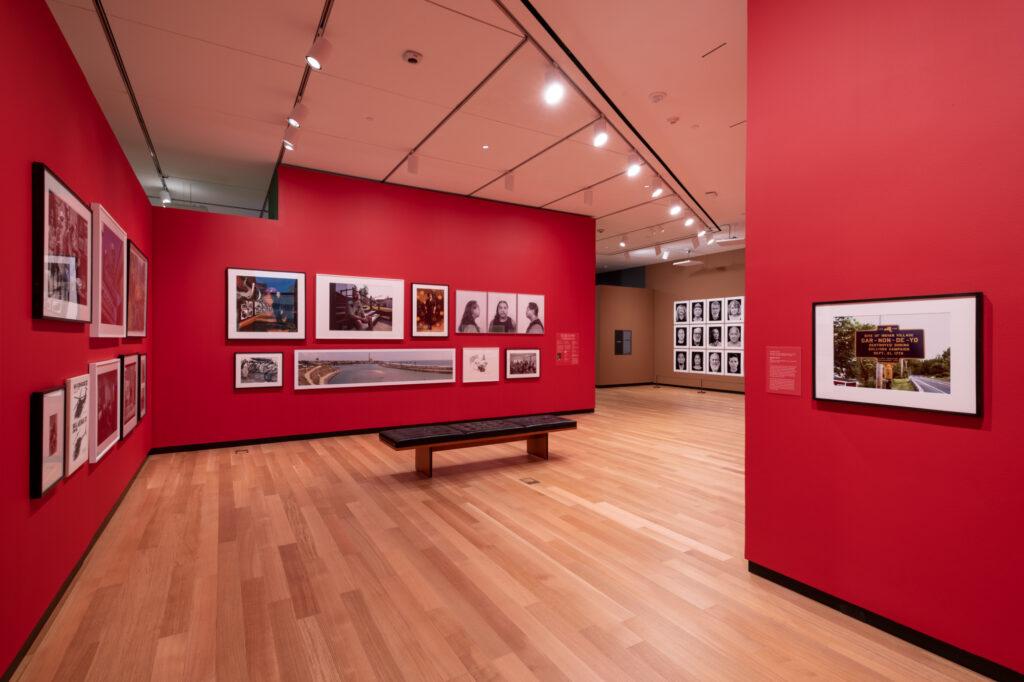
Left: Nothing Happened Here #3, 2017. Archival Inkjet Print.
Right: Installation photograph from Speaking with Light: Contemporary Indigenous Photography.
The arrows in each image act as a symbol of everlasting Indigenous presence in each scene. The images may be as compelling if the subjects were of Indigenous descent, but the decision to use non-native subjects reveals the shared burden. The question remains of how to overcome this troubled past.
Caruso: Connecting us back to New York, I heard from a mutual friend and artist, Sarah Cameron Sunde, you were part of her art residency[2]The Erie Canal Artist-in-Residence (AIR) program invites artists to explore the past, present, and future of this iconic waterway through their unique artistic lenses. A partnership between the New … Continue reading on the occasion of the Bicentennial of the Erie Canal.[3]The Erie Canal has been widely recognized as an engineering marvel. The Canal transformed New York City into the nation’s principal seaport and served as a major “Gateway to the West” for … Continue reading. Can you talk about the work you did there and your reflection on this infrastructure project?
Dennis: Sarah and I ended up going up to Syracuse, New York, and many of the small towns that are along the Erie Canal over the past months. I actually never visited the region before, even though I live in New York. The Erie Canal is this huge accomplishment, engineering-wise, but no matter where you stand along it, it does kind of look like this narrow path that you can’t imagine too much traffic at one time going through. So it’s a hard thing to fathom. It’s really abstract to understand the scale of the transformation.
Sarah was commissioned to create a body of work around the bicentennial by the Erie Canal Museum for this commemoration. I simply came in to add something to the concept she was already thinking about, but also to help document what she was hoping to present. I love the way that Sarah works, because she’s very socially engaged, she’s very open minded. She likes to go in any direction that could lead to something new; which is the same way that I work.
Caruso: Documentation is such a crucial aspect for performative art because it creates a lasting record of an ephemeral event, serving to preserve the work, provide a historical reference, and enable future research and exhibition.
Dennis: Totally. Something that I’m thinking a lot about as an artist is the fact I am often just a witness; I am a silent observer, trying to document as much as possible. Going back to the previous question that you asked about the Canal Project, we added more to documentation. We were thinking about the ways this work will go into the museum, how we talk about the history, and how to add perspectives to partially interrupt this idea of a triumph of American engineering.
When it comes to the Erie Canal and how I see and know more about it today, the big question is the fact that it is a horizontal scar in the land, and how so much funding and people’s hours go into maintaining it, but then, when you’re there, it’s so inactive. It divides communities. It’s kind of inconvenient for the people who live along it, and it’s really only there for recreational purposes now. So I think we were trying to figure out, how do we bring a new way of looking at it? What are new potentials for its space? And in New York City, we’re just scratching the surface, in terms of reactivating the natural environment.
Caruso: Bringing the conversation closer to home, as you know, the Seaport Museum is telling the history of New York from a maritime perspective, and is consciously making efforts to update how the public perceive maritime museums. This goes along with the general idea to shift from a more traditional narrow focus on “great men,” naval battles, or shipbuilding to a more expansive, interdisciplinary field that emphasizes the human relationships with the sea—which for us here at the Seaport Museum means a more accurate and comprehensive history of the New York archipelago.
When I was looking at your body of work, and trying (really hardily!) to make a selection of a few pieces to discuss with the Museum’s Collections Committee, I was struck right away with a photograph of yours, depicting a beach scene in Winter, covered in snow. As you mentioned, that piece of waterfront land and its story captivated me.

Circassian Shipwreck, 2017. Archival Inkjet Print. Museum Purchase, 2023.013.0001
Briefly, on December 30, 1876, the freight ship Circassian wrecked off the coast of Mecox Bay in Bridgehampton. Ten members of the Shinnecock tribe were among those who drowned while attempting to rescue the ship’s crew and cargo. Since the tragedy, the Shinnecock Nation has held remembrance gatherings that include drumming, dance, and feasting to remember the ancestors who gave their lives to support their community.
Dennis: I feel the same way, and it’s kind of funny, because here in the Hamptons, we have whaling and maritime museums and societies, but all of them kind of fall short in terms of telling the major contributions of Indigenous people who made that same industry possible early on, and the accomplishments of tribally-run ships and our captains.
The Circassian shipwreck site is one of the few examples though, and I think it is a little bit of a gap in my portfolio. I would love to add more beach scenes, whaling scenes, and research expedition content. This is in part because of that lack of local East End, Eastern Long Island resources. But, I think the South Street Seaport Museum might have the resources to assist me in such research, and I’d love to spend more time with your objects.
Caruso: Oh we would love that! When you visited the Seaport Museum and joined me in collections storage to discuss connections between your work and the thousands of objects we care for, did any particular thread stay with you?
Dennis: Whaling! I never knew that so much scrimshaw art existed in the world, as well as all the different uses of it. But I was also blown away by the prints and paintings depicting whaling and fishing scenes, and the tools you have, and harpoons.
Looking forward, I’m also working on the big anniversary for next year—the 250th anniversary of the Declaration of Independence—so I think myself, and so many others, are trying to get their hands on Revolutionary War props and artwork and memorabilia; so, should we work together on that?!
Caruso: Oh, I’d love to! For now, let’s say stay tuned for updates on how we will be celebrating the 250th!
Additional Readings and Resources
Jeremy Dennis website and projects: jeremynative.com
Sarah Cameron Sunde website and projects: sarahcameronsunde.com
“Indigenous Photograph” A database of Native American photographers from North America.
“Developing Stories: Native Photographers in the Field” A series of three photo essays created by Native photojournalists Donovan Quintero, Tailyr Irvine, and Russel Albert Daniels in collaboration with the Smithsonian’s National Museum of the American Indian. Smithsonian Institution, 2020.
“People of the Earth. What can artists, archivists, and communities learn from historic collections of Native photography?” by Wendy Red Star. Aperture Interviews. September 9, 2020.
“Spirit: Focus on Indigenous Art, Artists and Issues” By Griffin Museum of Photography, May 13, 2021.
“Through a Lens, Documenting Indigenous Culture” By Shane Mitchell. The New York Times, May 18, 2022.
“A Landscape Shared by Native Americans and the One Per Cent” By Robert Sullivan. The New Yorker, February 17, 2023.
References
| ↑1 | From “Wanda Nanibush Notions Of Land. For Indigenous artists, how can photographs provide a space of visual sovereignty?” Aperture magazine, Spring 2019 |
|---|---|
| ↑2 | The Erie Canal Artist-in-Residence (AIR) program invites artists to explore the past, present, and future of this iconic waterway through their unique artistic lenses. A partnership between the New York State Canal Corporation and the Erie Canal Museum, the AIR program is a celebration of creativity, history, and stewardship. The program supports the revitalization of the Erie Canal by blending art with storytelling to illuminate its cultural, environmental, and historical significance. Through exhibitions, events, and public programs, the AIR program brings new perspectives to the Canal’s lasting impact on New York State and the nation. |
| ↑3 | The Erie Canal has been widely recognized as an engineering marvel. The Canal transformed New York City into the nation’s principal seaport and served as a major “Gateway to the West” for waves of immigrants coming to America. Groundbreaking inventions and social movements took place along the canals where a spirit of entrepreneurship and progressive thinking took hold. The 363-mile-long Canal opened on October 26, 1826, and New York State Governor DeWitt Clinton (1769–1828) departed Buffalo, New York, leading a flotilla of boats across the canal to New York City. Learn more on the Erie Canalway National Heritage Corridor website. |
